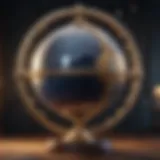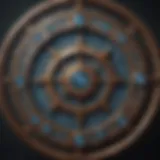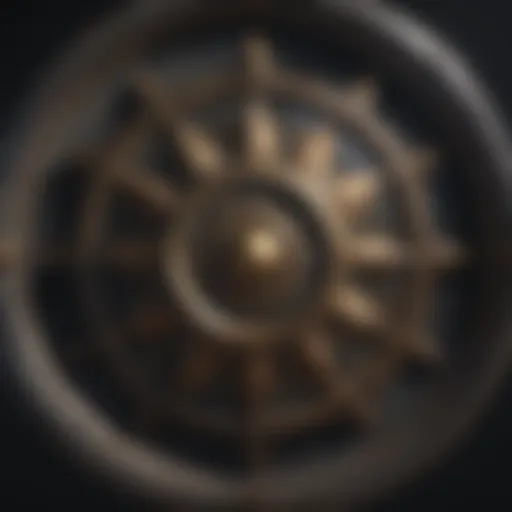Unlocking the Mysteries of Tarot Telling


Intro
Tarot telling captivates many people across the globe. It is more than just a deck of cards; it is a symbolic journey into the subconscious. People often seek guidance from tarot for various aspects of life, including love, health, and career decisions. It has roots in history, mysticism, and artistry, making it a colorful aspect of spirituality.
Developing an understanding of tarot involves grasping both its mechanics and its rich symbolism. Tarot readings can engage our intuition and provide clarity, offering insights that mere logic does not always reveal. This article aims to demystify the world of tarot, strengthening practitioners' skills whether they are newcomers or seasoned experts. Each section will unravel essential elements such as card interpretations, the importance of spreads, and personal growth impacts.
How to Interpret Tarot Cards
Understanding tarot cards requires exploring their structure and meanings. The tarot deck is typically divided into two main categories: Major Arcana and Minor Arcana.
Major and Minor Arcana
- Major Arcana consists of 22 cards that represent significant life events and spiritual lessons. Each card, from The Fool to The World, carries individual weight.
- Minor Arcana comprises 56 cards, which focus on day-to-day events. It is divided into four suits: Wands, Cups, Swords, and Pentacles. Each suit has its themes, allowing for nuanced interpretations during readings.
Meaning of Key Cards
Some key cards are particularly noteworthy:
- The Fool: Represents new beginnings and opportunities; a fresh start.
- The Lovers: Relates to difficulties in romantic relationships and key connections.
- The Death Card: A potent symbol of transformation, indicating endings that lead to new beginnings.
These cards, along with others, create a dynamic interpretation framework.
Sample interpretations in different spreads
When performing tarot readings, spreads play an essential role. A “spread” is the pattern in which cards are laid out. Popular examples include:
- Celtic Cross: Offers comprehensive insight into a question at hand;
- Three-Card Spread: Represents past, present, and future dynamics.
Each spread has its purpose, adapting to different inquiries and situations.
Overview of deck styles
Various tarot decks can be found, each with unique artistic expressions and philosophical orientaion, greatly influencing interpretations.
Popular decks and their unique features
- Rider-Waite: Renowned for its straightforward imagery and symbolism; a favorite among beginners.
- Thoth Tarot: Known for its rich and complex symbolic layers, appealing to experienced readers.
- Osho Zen Tarot: Focuses on spiritual themes and emotional growth, suited for profound introspection.
Choosing the right deck enhances one’s understanding spirit - always consider personal resonance.
The Relevance of Tarot in Personal Development
In contemporary settings, tarot transcends divination. It contributes to personal and psychological growth. Many seek lessons through tarot, reflecting patterns and uncovering potential latent in our lives. Here, intuition plays a pivotal role as readers synthesize meanings.
Culmination
Tarot telling holds relevance not just as a spiritual practice, but also as a pathway to self-understanding. By immersing oneself in card interpretations, understanding various decks, and mastering spreads, individuals equip themselves with tools for profound self-discovery. Readers are encouraged to explore their possibilities in intuitive realms, enriching their practice and comprehension of the mystic arts.
Preface to Tarot Telling
Understanding tarot telling is a fascinating journey into a blend of art and intuition, wrapped in rich history and cultural significance. This section lays the groundwork for anyone intrigued by tarot, whether they are novices exploring or experienced practitioners delving deeper. Recognizing the impact of tarot can open doors to personal reflection, guidance, and a connection to something profound. Through understanding its definition and historical roots, one can truly appreciate its place in contemporary society.
Definition and Overview
Tarot telling can be defined as a method of divination which utilizes a deck of tarot cards, each imbued with unique symbols and meanings. Generally, a standard tarot deck consists of 78 cards divided into the Major Arcana and Minor Arcana. The Major Arcana represents significant life events or spiritual lessons, while the Minor Arcana mirrors the complexities of daily life and smaller events.
At its essence, tarot serves two primary purposes: providing insights and fostering self-reflection. Through the interpretation of the drawn cards, individuals might gain perspectives on their past, present, or potential future situations. Those who explore tarot often reflect to their own emotions and thoughts while interacting with a reading.
Historical Context
The origins of tarot trace back to the 15th century in Europe, initially serving as a playing card deck. It's quite interesting to note that over the centuries, tarot evolved from mere entertainment into a tool for mysticism and spiritual exploration. The 18th century marked a pivotal transformation as scholars such as Antoine Court de Gébelin theorized on tarot's ancient roots linked to Egyptian wisdom. Thus, the perception of tarot changed significantly.
By the 19th century, a more systematic approach to tarot readings emerged, with figures like Arthur Edward Waite contributing to the understanding and use of tarot through published works. In today's world, tarot captures interest not just as a spiritual tool, but also as an expression of individual creativity and insight, leading to a rich tapestry of interpretations and practices.
Tarot offers multiple layers of access to self-exploration and understanding one's desires. It can illuminate unseen patterns in our lives.
The journey of exploring tarot telling promotes an enriched comprehension of the self and the cosmos around us. Each reading can serve as a bridge between the mundane and the extraordinary, weaving personal experiences and ancient wisdom into a tapestry of knowledge. By anchoring this understanding in the historical evolution of tarot, one may approach the cards with both reverence and curiosity.
The Mechanics of Tarot Readings
Understanding the mechanics of tarot readings is crucial for anyone delving into this form of divination. It unveils the components involved in constructing insightful and effective readings. Knowing how to select the right deck, coupled with a grasp of the card structure, enhances accuracy in interpretation.


Choosing a Deck
When one begins tarot reading, selecting a deck is among the first steps. The variety of tarot decks available can be overwhelming. Each deck has its own unique artwork and symbolism which can influence readings. Thus, it is essential to connect with a deck.
- Personal Connection: It is advised to choose a deck that resonates with personal aesthetics and understanding.
- Deck Features: Assess each deck's imagery and theme. Some decks lean toward traditional images, like the Rider-Waite, while others exhibit more modern art styles.
- Reading Energy: Feel the energy of the deck physically. Oftentimes, just holding a deck can trigger a connection beneficial for accurate readings.
Ultimately, the right choice fosters confidence during readings. Each reader's journey begins with this integral step.
Understanding the Card Structure
Getting familiar with the card structure enables a better comprehension of their meanings and implications within spreads. Tarot is structured into two main categories: Major Arcana and Minor Arcana.
Major Arcana
Major Arcana cards represent significant life themes and karmic moments. They often indicate powerful influences in the querent's life and form the backbone of a tarot reading. Each card conveys distinct meanings connected to various facets of human experience. Their key characteristics include:
- Depth of Meaning: Major Arcana cards delve into relevant life events.
- Cyclic Nature: They symbolize life lessons that recur over time.
- Popular Choice: Many readers regard this set as essential for understanding core spiritual themes and personal growth.
The unique feature of the Major Arcana lies in its ability to address pivotal life transitions. Readers seeking insight into broad themes typically benefit when focusing on these cards, although they can be quite intense.
Minor Arcana
Minor Arcana cards showcase the nuances of everyday life and situations. They break down into four suits, similar to standard playing cards. These relate more to the routine events one faces. Its key characteristics include:
- Practical Insight: Each suit provides context on day-to-day concerns like relationships and finances.
- Variety of Contexts: Unlike Major Arcana, these cards complement stories represented by the broader themes, often outlining specific situations.
The unique feature of Minor Arcana cards is the breadth they cover in life scenarios. They can illuminate minor challenges or conflicts, lending a supportive perspective to the larger-life themes presented by Major Arcana cards.
The balance created between both sections serves as a comprehensive picture of insights encountered during readings. By establishing a clarity on how to read these card structures, readers prepare themselves for deeper explorations in tarot telling.
Key Tarot Spreads
Understandig tarot spreads is crucial for effective tarot telling. Key tarot spreads help to structure the reading, giving an outline to the interpretation process. They serve as a tool that can clarify the context and energies present. Different spreads focus on various dimensions of life, aiding querents in concentrating on specific questions or areas of their existence. Each spread carries its own meanings and messages inherent within its layout, thus leading to clearer insights. Developing familiarity with these tarot spreads facilitates deeper intuition, embracing both the wisdom of tradition and personal responsiveness in readings.
Three-Card Spread
The three-card spread is one of the simplest yet profoundly effective spreads. It often covers past, present, and future, making it an excellent choice for those new to tarot. In this layout, each card represents a narrative thread, creating a journey through time. The past card sheds light on where the querent has come from; the present card indicates current influences; and the future card offers possible outcomes or guidance moving forward.
- Flexibility: This spread can be adapted to focus on various themes like love, career, or personal growth.
- Clarity: The brief structure encourages straightforward and concise interpretations.
- Accessibility: Ideal for beginners, it offers a low barrier to entry to the practice of tarot.
While the simplicity is an asset, one must remember that layers of meaning can enrich even basic spreads. The depth comes from the querent's question and the intuition of the reader working with the cards.
Celtic Cross Spread
The Celtic Cross spread is one of the most celebrated and versatile tarot layouts. It delves deeper beyond surface questions, exploring more complex dimensions of a situation. Usually comprising ten cards, the spread conveys a detailed panorama of influences surrounding a querent. Each position reveals specific information about different aspects of their life and unfolding events.
- The Present Situation - Core issues at hand.
- Challenges - Current obstacles that hinder progress.
- Conscious Goals - What the querent desires consciously.
- Unconscious Influences - Hidden factors affecting the situation.
- Past Influences - Old energies playing a role.
- Future Direction - Immediate path ahead.
- Advice - Guidance from the cards.
- External Influences - Outside forces wrecking abut the querent.
- Hopes and Fears - Aspirations but also hidden anxieties.
- Outcome - Likely culmination based on current energies.
Using this spread demands practice and experience, as it requires keeping track of various narratives running concurrently. However, its richness provides deeper insight, guiding actionable steps for the querent.
Relationship Spread
The relationship spread is specifically designed to analyze dynamics between two people, whether in a romantic, platonic, or familial context. This layout typically utilizes a minimum of six cards, focusing on the energies at play within the relationship.
- Distinct Roles: Displays each person's role within the dynamics, identifying shared strengths and weaknesses.
- Connection Significance: Offers insights into feelings, actions, and hopes from both parties' perspectives, revealing underlying motivations.
- Advice on Healing or Growth: Highlights areas of compatibility and offers suggestions for improvement.
Utilizing this spread can be incredibly revealing, especially when navigating conflicts or uncertainty in interpersonal relationships.
Understanding key tarot spreads allows practitioners and inquirers alike to harness the potential insights tarot offers. Thus enriching the tarot experience and enhancing clarity in decision-making.
Interpreting Tarot Cards
Interpreting tarot cards is a fundamental aspect of tarot reading. Understandably, readers interpret various cards based on individual insight and context. This section delves into the intricacies that govern the interpretation, highlighting symbolism, the reader’s intuition, and prevalent themes. The aim is to uncover the multi-layered meanings that reside within each card placement.
Symbolism in Tarot
Symbolism in tarot is key to unraveling the messages the cards convey. Each card is embedded with images that carry historical, cultural, and esoteric meanings. For instance, the High Priestess represents intuition and inner wisdom, illustrated by her calm presence and the moon at her feet. Such symbols require thoughtful consideration during readings. Tarots can be diverse, but common archetypes recur, like transformation represented by the Death card or new beginnings signified by the Fool.
Also, colors play a vital role in symbolism. A card with warm hues might suggest optimism while cooler tones can imply introspection. Certain symbols transcend time and geography, forging a universal language helping in interpretation.
Intuition and Interpretation
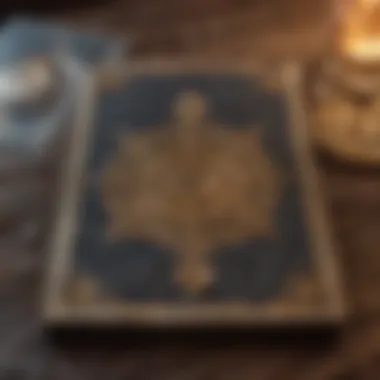

Combining intuition with traditional card meanings enhances interpretations. Intuition acts as the guiding force for many tarologists. It can arise from a feeling sparked by a card or an impression influenced by the current reading situation. Proficient readers often hone their intuition to decipher messages filled with nuance.
Establishing a connection with the cards goes beyond memorizing meanings. Some readers prefer to meditate with particular cards before engaging in readings. This practice fosters a deeper understanding of the symbols, amplifying emotional responses and insights during interpretations.
A reader should balance between personal intuition and established meanings, tailoring interpretations based on context. Card positions in spreads can alter initial meanings, requiring flexible thinking.
Common Themes and Messages
Throughout tarot readings, certain themes and messages consistently arise. Commonly represented topics include self-discovery, relationships, and personal challenges.
For example:
- Love and Relationships: A spread involving the Two of Cups often signifies deep emotional connections, whereas the Three of Swords might highlight heartbreak.
- Challenges: The Eight of Swords is illustrative of feelings of being trapped, while the Nine of Wands suggests resilience despite struggles.
These common themes permit readers to engage clients through relatable narratives. Ultimately, consolidation of insights empowers individuals whether in self-reflection or decision-making processes. Readers should cultivate awareness of recurring motifs specific to their own experiences.
“The tarot is not just a tool for psychic interpretations; it serves as a mirror, bringing deeper awareness to personal journeys.”
By embracing the intricate act of interpreting tarot cards, practitioners forge a profound connection to meaning on both personal and societal levels. This capability transforms readings into guides that unveil life’s different facets, thereby enriching the reader's understanding of themselves and the universe.
The Role of Intuition
Understanding intuition’s role in tarot reading is fundamental to fully grasp the intricacies of this art. Intuition serves as a guiding force that enables the reader to connect deeper with the cards. It offers insights beyond logical reasoning, allowing for a unique personal interpretation. Recognizing this duality can be significant in enhancing reading effectiveness. The balance between intuition and logic shapes the overall interpretation given to clients.
Developing Intuition in Readings
Cultivating one's intuition is crucial for any effective tarot reading. It often involves practices that sharpen both instinct and perception. Engaging regularly with the cards can result in a stronger bond with the symbolism and archetypes portrayed. This could include daily draw exercises, where one selects a card and reflects on its meaning. Journaling about these reflections further facilitates personal growth in interpretation skills.
It can be useful to observe subtle shifts in feelings or thoughts when drawing cards. Paying attention to gut reactions while spreading the cards can uncover unformulated views and ideas that guide the reading process.
Some methods to improve one’s intuition are:
- Meditation to quiet the mind
- Keeping a tarot journal for insights
- Practicing mindfulness during readings
By doing these, you enhance intuitive capabilities, giving rise to clearer interpretation and insight.
Balancing Logic and Emotion
The reconciliation of logic and emotion is important in a tarot reading. Logic provides a structured framework for understanding card meanings. However, to generate a deeper reading, interpretations also require emotional insights. This harmony allows the energy of readings to resonate true with clients.
It can be helpful to consider logical perspectives, such as card positions and historical meanings, alongside personal emotional responses to the imagery of the cards. Recognizing when to draw upon rational understandings and when to delve into emotional narratives can steer the meaning behind tarot more accurately.
By applying both approaches, tarot readers can offer richer consultations and insights, leading to transformative experiences for clients.
"Intuition integrated with logic crafts profound revelations that structure experiences and choices."
This balance often makes the difference in effective tarot practice, ensuring a comprehensive overview that resonates emotionally while meeting cognitive understandings.
In summary, the role of intuition goes hand-in-hand with logic, augmenting the ability to provide meaningful insights and deepen the connection between tarot readers and their clientele.
The Psychological Aspects of Tarot
The exploration of tarot extends beyond symbolism and card interpretations; it penetrates deep into the psychological realm. Understanding the psychological aspects of tarot allows practitioners to appreciate its potential as a transformative tool. This section delves into how tarot functions as a mirror to the psyche, enabling self-discovery and emotional growth.
Tarot as a Tool for Self-Reflection
Tarot is often recognized for its mystical and divinatory nature, but it serves importantly as a medium for self-reflection. When an individual engages with the cards, they are prompted to consider their thoughts, emotions, and circumstances. Each card selected during a reading can reveal subconscious patterns and buried feelings. By contemplating these cards, individuals gain insights that may not be apparent in their daily lives.
The act of interpreting the cards can be an introspective journey. For example, drawing the Seven of Cups might suggest confusion or indecision. In reflecting on this card, a person may recognize areas where they feel overwhelmed by choices and, consequently, start to seek clarity in those areas.
Moreover, tarot encourages a narrative framing mode that promotes personal storytelling. This process helps clients construct meaning around their experiences, transcending mere moments to embrace cycles of growth. It's important to approach such reflections with honesty, as this promotes genuine progress and understanding.
Cognitive and Emotional Benefits
Apart from the self-reflective aspects, tarot bestows various cognitive and emotional benefits that can aid personal development. Engaging with tarot readings stimulates both creative and analytical thinking, offering a duality that can enhance problem-solving skills.
Some key benefits include:
- Cognitive engagement: The deliberative process of tarot reading requires logical thought, pattern recognition, and intuition. It activates several cognitive pathways that may otherwise stay dormant in day-to-day life.
- Emotional catharsis: Expressing feelings framed through the lens of tarot can offer emotional release. It helps individuals track feelings over time and recognize repetitive emotional patterns.
- Enhancement of self-awareness: By consciously engaging with various elements in readings, a person becomes more attuned to their inner workings, biases, and emotional triggers.
- Reduced anxiety: Regularly exploring tarot may minimize anxieties related to the future. The cards serve as tools to collectively address dilemmas or uncertainties, transforming them into threads of a larger narrative.
Engaging with tarot has therapeutic potential, unlocking pathways to understanding that may evade traditional means.
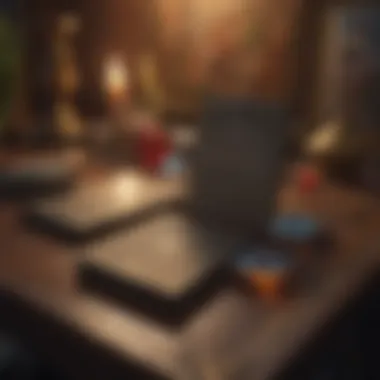

Integrating these psychological benefits helps entrenched beliefs and provides transformative avenues for personal development. Through tarot, practitioners can attain a balance of emotional clarity and cognitive insight, collectively knitting together strands of a fulfilling narrative journey.
Challenges in Tarot Telling
Understanding the challenges in tarot telling is crucial for both the practitioner and the querent. Navigating the complexities of tarot readings involves more than just familiarity with the cards or the layouts. It requires awareness of potential pitfalls and ethical responsibilities. Having knowledge of these areas helps avoid misinterpretations that can lead to confusion or misleading conclusions.
While tarot can offer profound insights and guidance, the process is delicate. Practitioners must approach readings with both humility and caution. Doing so not only protects the querent’s emotional wellbeing but also enhances the practitioner’s credibility. Overall, recognizing these challenges allows for deeper engagement with the tarot practice while promoting a safe and respectful environment.
Misinterpretation Risks
Misinterpretation is a prominent risk during tarot readings. Each card can hold multiple meanings, and this nuance may lead to different conclusions based on the question posed. A reader's biases and emotional state can color interpretations, unintentionally skewing the message conveyed.
Some common pitfalls include:
- Taking the imagery literally without consideration for context.
- Overemphasizing one's preferred meanings while ignoring others.
- Failing to clarify questions, leading to vague answers.
To minimize these risks, a disciplined approach is essential. Readers should remain open to various interpretations and be conscious of their thought processes. Continuous self-reflection improves understanding and paves the way to refine one's interpretations. Having feedback from other practitioners can also prove invaluable.
Ethical Considerations
Ethics play a significant role in tarot reading practices. Given the sensitive nature of life questions, maintaining ethical standards is essential for building trust. Practitioners must consider how their insights might affect a querent's decisions or emotions.
Key ethical aspects include:
- Informed Consent: Always ensure the querent understands what a reading entails and is comfortable moving forward.
- Confidentiality: Protect the privacy of the querent's information to foster a safe environment.
- Avoiding Overreliance: Encourage autonomy by promoting the idea that tarot serves as guidance, not a deterministic tool.
Exercising ethical standards cultivates a more responsible tarot practice. Practitioners should regularly reflect on their methodologies and seek knowledge from ethical frameworks associated with spiritual practices. This careful approach not only protects the querent but also enhances the integrity of tarot as a discipline.
"Tarot reading can serve others, but it is the practictioner's job to uphold the responsibility attached to this tool."
Navigating these challenges will foster not only the querent's growth but also bolster the evolution of the tarot reader into an insightful and grounded facilitator.
Tarot in Contemporary Practices
Many practitioners today find that tarot has transcended its traditional roots, becoming an integral part of modern spirituality. Understanding how tarot fits into the contemporary context adds significant depth to the practice of tarot telling.
The benefit of tarot in contemporary practices lies in its adaptability. It serves many purposes for various people, ranging from self-discovery to seeking guidance in complex life situations. By integrating tarot with personal spirituality, individuals create a unique approach that resonates with their personal beliefs and values.
Integration in Modern Spirituality
Tarot plays a vital role in modern spirituality, often serving as a powerful tool for personal growth. Many modern practitioners incorporate tarot into their spiritual routines, using the cards as focal points in meditation or reflection. The symbolism contained within the tarot can prompt analysis of one's inner thoughts, beliefs, and emotions. Through consistent use, individuals may uncover deeper insights into their psyches, leading to transformative experiences.
The relevance of tarot can be demonstrated in different spiritual practices:
- Meditation: Meditating on specific cards allows individuals to contemplate core life themes, bringing clarity and comprehension.
- Manifestation: Some use tarot in conjunction with manifestation techniques, aligning their intentions with the messages from the cards, nurturing a clearer pathway to achieve their goals.
- Rituals: Incorporating tarot into ritual practices adds a layer of symbolism that many feel enhances the experience, fostering a sense of connection to broader spiritual traditions.
Balancing traditional interpretations with personal insights is crucial. Tarot interpretations must be adjusted to suit modern contexts without dismissing historical meanings. This fusion creates a rich tapestry of individual spiritual journeys.
Online Tarot Communities
The rise of online platforms has significantly reshaped the landscape of tarot reading and sharing. Online tarot communities emerge predominantly on sites like Reddit and Facebook, where individuals can come together to discuss insights, challenges, and experiences related to tarot.
Engaging in these communities provides communal support that many might find valuable:
- Learning Resources: Newcomers can access a wealth of information through tutorials, forums, and discussions. Experts often share their wisdom, broadening the understanding of tarot basics and advanced interpretations.
- Reading Feedback: Many practitioners seek advice on specific readings. These platforms allow for sharing readings, receiving critiques, and adapting methodologies based on feedback.
- Diverse Perspectives: Community interactions bring forth various interpretations of card meanings and readings. Respect for diverse viewpoints can stimulate protestation and innovations in tarot practice.
Ultimately, congregating in digital spaces promotes bonds that transcend geographical boundaries. This bridging of perspectives contributes significantly to collective growth in understanding. Embracing these online resources can help deepen one's practice significantly while contributing to the evolving narrative within the tarot community.
Ending
In this article, we have thoroughly examined the multifaceted world of tarot telling. The conclusion encapsulates the significant elements at play in this ancient practice. Understanding tarot is not just about the card's appearance but also its deep symbolism and possible interpretations. Each reading can unveil layers of insight used for personal reflection or decision-making.
Recap of Key Points
Tarot telling serves as a profound tool with several important takeaways:
- Historical Origins: Tarot has a deep-rooted history intertwined with several cultures and beliefs. Its evolution informs current practices.
- Mechanics of Readings: From choosing a deck to interpreting card meanings, we discussed essential mechanics that dictate how tarot works.
- Intuition's Role: Development of intuition is paramount. Balancing it with logic enables accurate readings.
- Psychological Benefits: Tarot offers cognitive and emotional benefits, acting as an aid for self-reflection and personal growth.
- Challenges and Ethics: The practice encompasses various risks of misinterpretation and ethical issues one must navigate.
- Modern Relevance: Its integration into contemporary practices showcases tarot's place in modern spirituality.
Further Exploration
To deepen your understanding of tarot telling, consider engaging with additional resources:
- Explore online communities such as Reddit that discuss tarot and share experiences.
- Reference detailed articles on tarot through platforms like Britannica and Wikipedia.
- Seek local workshops or online webinars that allow you to observe live readings and participate in discussions.
Astrologers, tarologists, and esotericists can all gain valuable insights from further exploration of tarot's various aspects. Each element within humanity, intuition, and ancient practices contributes to a deeper comprehension of tarot's importance today.
"The cards tell a story, but the interpretation lies with the reader's intuition and understanding."
By continuously studying and practicing, those interested can cultivate a distinctive approach in their tarot practice, enhancing not only their skills but their intuition as well.
